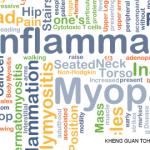Dr. Vivino ended by discussing appropriate treatment for Sjögren’s, recommending immunosuppressives, such as hydroxychloroquine, or corticosteroids, but warned that these don’t have proven benefit for dry mouth or dry eyes.
Hear the Sessions
These and other sessions from the ACR State-of-the-Art Clinical Symposium are available as audio CDs, MP3s, and podcasts. Visit www.ACRMeetings.com to view the sessions currently available from the meeting.
Distinguish Myopathy from Mimics
In “Myositis: From Autoantibodies to Clinical Trial,” Chester V. Oddis, MD, professor of medicine at the University of Pittsburgh, provided guidelines for diagnosing and treating myositis syndromes.
Dr. Oddis began by reviewing the diagnostic criteria for idiopathic inflammatory myopathy, which include:
- Symmetric proximal muscle weakness;
- Elevation of serum muscle enzymes (creatine kinase, aldolase, aspartate aminotransferase, alanine aminotransferase, or anti-diuretic hormone);
- Myopathic electromyographic abnormalities;
- Characteristic muscle pathology; and
- Skin rash of dermatomyositis.
He then discussed several mimics of inflammatory myositis, including endocrine myopathies of hyper- and hypothyroid, metabolic myopathies, muscular dystrophies, and (the most common) drug or toxic myopathies caused by alcohol, colchicines, statins, and more.
“We all struggle with statins and statin myopathy,” said Dr. Oddis. Factors that increase risk of statin myopathy include increasing age, female gender, renal insufficiency, hepatic dysfunction, hypothyroidism, diet, and polypharmacy.
Dr. Oddis recommended a muscle biopsy to distinguish myopathy from immune-mediated myositis, or polymyositis, that’s amenable to treatment with steroids.
“In a patient with refractory polymyositis, consider the mimics of inflammatory myopathy,” he advised, “and you also have to consider inclusion body myositis [IBM].” Although it’s the most common myopathy, this is often missed. IBM is more prevalent in elderly males and includes an insidious onset of painless muscle weakness with slow progression. There’s a characteristic pattern of muscle atrophy in forearm flexors, quadriceps, and intrinsic muscles of the hands.
Although dermatomyositis (DM) may appear to be polymyositis with a rash, “it’s much more complicated than this,” explained Dr. Oddis. In polymyositis, the target is myofiber; in dermatomyositis, the target is blood vessels—treatment for the two must be different.
In a classic DM model, the autoimmune disease is mediated by an adaptive immune system and you’ll find a locally humorally mediated response with B and T helper cell infiltration. You’ll also find perifascicular atrophy of muscle fibers caused by ischemia. But investigations over the last few years have found specific gene transcriptional patterns in DM muscle tissues, including genes identified as type 1 interferon-induced. This is similar to a genetic signature found in lupus.

